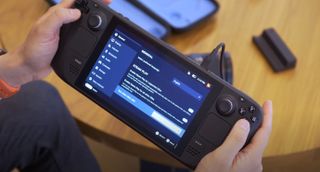The Steam Deck can drain its battery in 90 minutes if you don't cap your fps
Battery life is looking good for indie games—and triple-A, as long as you make sure to tweak the right settings.

According to Valve we can expect somewhere between 2-8 hours of battery life from the Steam Deck, depending on how demanding a particular game is on the hardware. Now early testing from several YouTube channels gives us some real data to measure up against that claim, and it's clear that 2 hours is not the absolute minimum for the Steam Deck's battery. It ran out of juice a full 33 minutes quicker in GamersNexus' testing.
GamersNexus ran a range of battery tests, including Devil May Cry 5 with an uncapped framerate and Vsync disabled. With those settings the Steam Deck lasted 87 minutes—and that was with brightness set to 50%. For comparison, DMC 5 lasted a full two hours with Vsync enabled, slightly lower settings, and a 60 fps framerate cap.
YouTuber The Phawx also ran intensive battery life tests to determine the worst case performance with the Steam Deck, and came to a very similar number using the game Control: 85-90 minutes. "If you turn Vsync off and have low settings and 90 fps when there's no reason to—you have a 60Hz display—you can inadvertently have terrible battery life," he says. Both channels tested one of the other games Valve made available for previews, Dead Cells, and got six hours of battery life with Vsync enabled. It's a sign that indie games and older, less graphically demanding PC games will likely be able to run for several hours on the Steam Deck, though neither test came close to Valve's stated upper limit. "For the life of me, I never managed to get to eight hours," The Phawx said.
This testing highlights one of the key differences between the Steam Deck and traditional game consoles like the Nintendo Switch: configuring your games with the proper settings will be vital to getting the most juice out of the system. In Forza Horizon 5, The Phawx was able to get around four hours of battery life by locking the framerate to 30 fps and making a few settings adjustments.
Shooting for 60 fps will broadly mean lower battery life in modern games—about two hours, judging by what we've seen so far—but older and lighter games should be more in the 4-6 hour range. Whichever target you shoot for, setting an fps limit will ensure you're not wasting processing power and battery life.
One other bit of good news from GamersNexus's testing: the Steam Deck is fairly quick to charge. While turned on (and idle), the Steam Deck can charge to 80% battery in 100 minutes. It'll take another 80 minutes to reach a full charge—just like smartphones, the Steam Deck slows its charging rate after a certain point to preserve the longevity of the lithium-ion battery.
Some early tests of the Steam Deck published today also revealed that micro SD card load times are surprisingly fast, often even matching the internal SSD.
The biggest gaming news, reviews and hardware deals
Keep up to date with the most important stories and the best deals, as picked by the PC Gamer team.

Wes has been covering games and hardware for more than 10 years, first at tech sites like The Wirecutter and Tested before joining the PC Gamer team in 2014. Wes plays a little bit of everything, but he'll always jump at the chance to cover emulation and Japanese games.
When he's not obsessively optimizing and re-optimizing a tangle of conveyor belts in Satisfactory (it's really becoming a problem), he's probably playing a 20-year-old Final Fantasy or some opaque ASCII roguelike. With a focus on writing and editing features, he seeks out personal stories and in-depth histories from the corners of PC gaming and its niche communities. 50% pizza by volume (deep dish, to be specific).
Most Popular







